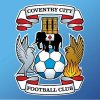Alan Dugdales Moustache
Well-Known Member
If anyone can post up a picture of our proud badge, i'd be very grateful. I'm too thick to know how to do it.
Anyway, my question is quite straightforward.
There are two phoenix either side of the crest. The one on the left has a foot touching the ball (well it has on my flag ) while the one on the right is in flames.
Is the one on the right symbolic of the City of Coventry burning in WW2 , in which case the Phoenix on the left must be the one rising from the ashes, or is the phoenix on the right the one rising from the ashes as it is surrounded by flames ?
I need help. I feel I should know this.
Anyway, my question is quite straightforward.
There are two phoenix either side of the crest. The one on the left has a foot touching the ball (well it has on my flag ) while the one on the right is in flames.
Is the one on the right symbolic of the City of Coventry burning in WW2 , in which case the Phoenix on the left must be the one rising from the ashes, or is the phoenix on the right the one rising from the ashes as it is surrounded by flames ?
I need help. I feel I should know this.


